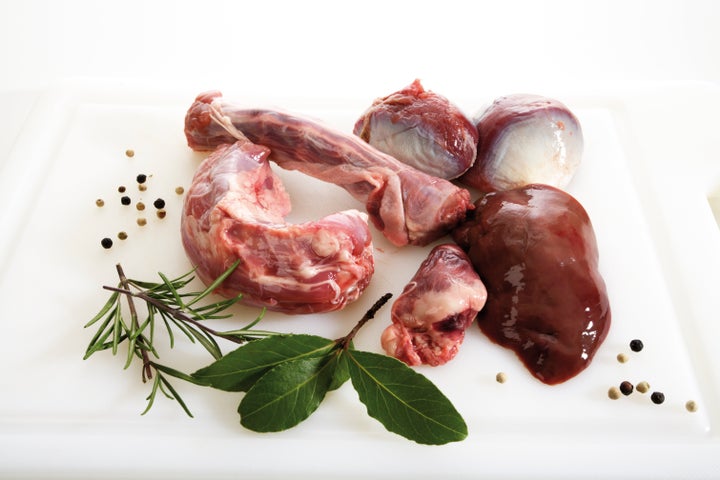
If you’ve ever brought home a Thanksgiving turkey and fished around its insides, you’ve likely found a little bag of mysterious turkey bits known as giblets. And while many home cooks throw it in the garbage with disgust, it shouldn’t be overlooked.
The offal, or the organ meats of animals, aren’t usually widely available — but turkey is the exception.
“It is the only example I can think of in modern meat-buying in America where meat itself comes with organs, as if the internal organs are saying, ‘Please eat me, too! I’m also delicious!’” said Dr. Jonathan Reisman, a physician, author and creator of Anatomy Eats, a series of dinners where patrons eat parts of animals that are usually discarded, while Reisman explains the animal’s anatomy.
So what exactly is in that bag?
Unwrap a turkey and you are likely to find a little sack of organs inside the bird’s cavity wrapped in a small paper bag.
“Those organs and body parts inside the turkey are called the ‘giblets’ and they usually consist of the heart, liver, gizzard and neck,” Reisman explained. “These are delicious parts of the bird that should definitely be eaten,” and not just used for flavouring, he added. Giblets can be prepared in a variety of ways to add interest to traditional Thanksgiving dishes or to create entirely new creations.
Throw them in the roasting pan
No one should gobble giblets down raw, but most of the time they come ready to cook, and no special preparation is needed to make them delicious. Chef Rodney Freidank from Table 301 in Greenville, South Carolina, usually puts the giblets “in the roasting pan with the turkey and the vegetables and cook them.”
As an easy alternative, giblets “can be stuffed back into the bird” after removing them from the paper sack they come in, Reisman said. To give giblets a bit more flavour, Reisman puts the neck into the turkey pan to cook, and “fries the other organs separately since they cook pretty fast.”
Make gravy with the giblets
If you want to do something more creative with your giblets, Freidank suggests making “giblet gravy,” a popular Southern holiday dish.
Chef Janet Bourbon, senior strategic chef at Cargill Protein, offers her recipe. ”[Put the] neck and wing tips in a pot with half an onion, carrots, and a bit of celery in a pot, cover them with water and bring to a boil then simmer for 2-3 hours.” Once done cooking, Bourbon strains the solid parts and reserves the liquid for gravy. “It will be decadent and full of flavour,” she said. To add even more interest to giblet gravy, Bourbon says to “roughly chop the gizzard, liver and heart. Sauté in butter until browned,” and add the mixture to your gravy. “Absolutely perfect for the holidays,” she said.
Derek Brooks, executive chef at the Waldorf Astoria in Washington, D.C, only uses the turkey neck when making giblet gravy. He likes to roast the necks just enough “to get some colour” before braising them with turkey stock and mirepoix (chopped celery, carrots, and onions sautéed in butter or oil) until tender. “Then I remove all the meat from the vertebrates, rough chop, and add the meat into the gravy,” he said. “The turkey neck meat helps thicken the gravy and adds a ton of flavour,” Brooks added.
Add them to your stuffing
Stuffing is another classic Thanksgiving dish that can be enhanced with giblets. Chef Nicholas Stefanelli at The Morrow in Washington, D.C., likes to add cooked hearts, liver and gizzards to the stuffing with roasted chestnuts. Adding these parts to the stuffing adds depth to the flavour.
Add it to bolognese
If you want to use these turkey parts for a nontraditional Thanksgiving dish, chef Alex Chen at Wild Blue Restaurant & Bar in British Columbia, Canada, suggests using turkey livers, hearts and gizzards to make bolognese. “It is delicious. Just treat the organ meats like ground beef,” he said.
To prepare the giblets for bolognese, Chen poaches “the heart and gizzard in butter like a slow confit” before submerging them in unsalted butter, sage leaves and garlic and cooking them for an hour. “Chill and food process until they’re small chunks like cooked ground beef and hand-dice the liver,” he suggested.
Don’t overlook the “turkey butt”
Reisman’s favourite part of the turkey isn’t always sold with turkeys in the supermarket. The “big fatty lump at the end of the tail,” called a pygostyle, is sometimes sold separately and smoked. Reisman says that the pygostyle, also called “smoked turkey butts,” is a lump of fatty meat that contains an oil-secreting gland.
“I think this is the most delicious bite or two on the entire turkey,” Reisman said. Chef Ruffy Sulaiman at Hilton Americas-Houston added, “Turkey tail offers a delicious meat-to-fat ratio, making them excellent for smoking or roasting with a spicy glaze like honey chipotle.”